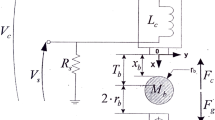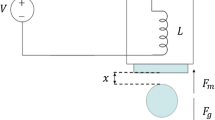Abstract
Nonlinear \({H}_{\infty }\) control is a promising way of attenuating negative effects of external disturbances in nonlinear systems and is robust against uncertainties of the plant. However, partial differential equation (PDE) obtained from this method rarely can be solved analytically. Thus, some sort of approximation is required. Furthermore, produced controllers by this method using Taylor series approximation (especially higher order controllers) are complicated and hard to implement. In this paper, a robust and nonlinear controller is introduced which combines linear \({H}_{\infty }\) controller and feedback linearization technique. First, a nonlinear state transformation is applied to the nonlinear system such that the resulting system is linear. Next, a linear \({H}_{\infty }\) controller is designed for the feedback linearized system. By this method, approximation is not required in designing \({H}_{\infty }\) controller because for linear systems, resulting PDE is simplified to a Riccati equation. Proposed approach has been applied to a Magnetic Levitation (Maglev) system, and its performance is compared with third-order nonlinear \({H}_{\infty }\) controller to verify the effectiveness and robustness of new method. Simulation results show that proposed controller attenuates external disturbance much better than nonlinear \({H}_{\infty }\), and simultaneously has less control effort.





Similar content being viewed by others
References
Abu-Khalaf, M., Huang, J., & Lewis, F. L. (2006). Nonlinear \(H_2/H_{\infty }\) constrained feedback control (1st ed.). London: Springer.
Aliyu, M. D. S. (2011). Nonlinear \(H_{\infty }\) control, Hamilton–Jacobi equations. London: CRC Press, Taylor & Francis.
Al-Muthairi, N. F., & Zribi, F. (2004). Sliding mode control of a magnetic levitation system. Mathematical Problems in Engineering, 2, 93–107.
Bachle, T., Hentzelt, S., & Graichen, K. (2013). Nonlinear model predictive control of a magnetic levitation system. Control Engineering Practice, 21(9), 1250–1258.
Bea, R. W. (1998). Successive Galerkin approximation algorithms for nonlinear optimal and robust control. International Journal of Control, 71(5), 717–743.
Bittar, A., & Sales, R. M. (1997). \(\text{ H }_{2}\) and \(\text{ H }_{\infty }\) control applied to an electromagnetically levitated vehicle. InProceeding of the IEEE International Conference on Control Applications (pp. 773–778). Hartford.
Chen, S.-Y., Lin, F.-J., & Shyu, K.-K. (2009). Direct decentralized neural control for nonlinear MIMO magnetic levitation system. Neurocomputing, 72(13–15), 3220–3230.
Hengkun, L., Xiao, Z., & Wensen, C. (2009). PID control to Maglev train system. In International Conference on Industrial and Information System (pp. 341–343). Haikou.
Isidori, A., & Kang, W. (1995). \(\text{ H }_{\infty }\) control via measurement feedback for general nonlinear systems. IEEE Transactions on Automatic Control, 40(3), 466–472.
Morales, R., & Sira-Ramirez, H. (2010). Trajectory tracking for the magnetic ball levitation system via exact feedforward linearization and GPI control. International Journal of Control, 83(6), 1155–1166.
Nataraj, P., & Patil, M. D. (2008). Robust control design for nonlinear magnetic levitation system using quantitative feedback theory (QFT). In Annual IEEE India Conference (INDICON) (pp. 365–370). Mumbai.
Shieh, H.-J., Siao, J.-H., & Liu, Y.-C. (2010). A robust optimal sliding-mode control approach for magnetic levitation systems. Asian Journal of Control, 12(4), 480–487.
Sinha, P. K., & Pechev, A. N. (1999). Model reference adaptive control of a Maglev system with stable maximum descent criterion. Automatica, 35(8), 1457–1465.
Sinha, P. K., & Pechev, A. N. (2004). Nonlinear \(\text{ H }_{\infty }\) controllers for electromagnetic suspension systems. IEEE Transactions on Automatic Control, 49(4), 563–568.
Tian, F., & Nagurka, M. (2012). Robust control design of a single degree-of-freedom magnetic levitation system by quantitative feedback theory. In Proceedings of the ASME/ISCIE 2012 International Symposium on Flexible Automation (pp. 109–115). St. Louis, MO.
Willems, J. C. (1972). Dissipative dynamical systems-part I: General theory. Archive for Rational Mechanics and Analysis, 45(5), 35–321.
Author information
Authors and Affiliations
Corresponding author
Rights and permissions
About this article
Cite this article
Javadi, A., Alizadeh, G., Ghiasi, A.R. et al. Robust Control of Electromagnetic Levitation System. J Control Autom Electr Syst 25, 527–536 (2014). https://doi.org/10.1007/s40313-014-0140-8
Received:
Revised:
Accepted:
Published:
Issue Date:
DOI: https://doi.org/10.1007/s40313-014-0140-8




